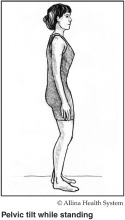
Second trimester: Having a healthy pregnancy
Don't use tobacco
If you haven't been able to quit smoking yet, it's not too late. Quitting tobacco as soon as possible is the best for you and your baby. All tobacco products, including electronic forms, are considered dangerous to you and your unborn baby. Learn more abut the risks of tobacco use during pregnancy and check out the quitting tobacco section on the resources page.
Eat well
Your appetite may be increasing now. Be sure to eat foods that are rich in nutrients. See the list of top 20 foods for pregnancy. Check with your health care provider about the rate of weight gain that is best for you. Often it is about one pound a week.
Exercise
The extra energy you are likely to feel will make it easier to take a walk or add exercise into your daily routine. See the get exercise section for some exercise tips and guidelines.
When you start your second trimester, it's best not to exercise while lying on your back. Lying on your back after the first trimester can reduce the amount of blood that goes to your uterus and baby. Start doing exercises in the side-lying, standing, or hands and knees position.
Pelvic tilt and rocking
To prevent or reduce lower backache, do pelvic tilt exercises. This exercise tightens your abdominal muscles and moves your pelvis. The action of a pelvic tilt flattens your back. If you put your hand under the small of your back, you should feel your back pushing on your hand when you tilt your pelvis.
After the first trimester do not do the pelvic tilt lying down. You can stand or get on your hands and knees.
Standing

- Stand with your knees slightly bent. Your pelvis needs to be able to move easily.
- Take in a comfortable breath.
- Tighten your abdominal muscles and tuck your buttocks. This will tilt your pelvis and flatten your back. Hold for five seconds. Exhale slowly when you tighten and hold.
- Release and inhale.
- Rest for five to 10 seconds.
- Repeat the cycle 10 times.
If you stand against a wall, put your hand between the wall and your back at about the level of your waist. The distance between your back and the wall should get smaller when you tilt your pelvis.
On hands and knees
- Get on your hands and knees.
- Keep your back straight. Do not hollow your back.
- Take in a comfortable breath.
- Tighten your abdominal muscles and tuck your buttocks. This will tilt your pelvis and flatten your back. Hold for five seconds. Exhale slowly when you tighten and hold.
- Release and inhale.
- Rest for five to 10 seconds. Don't let your back sag while you are resting.
- Repeat the cycle 10 times.
Pelvic rocking
To do pelvic rocking, do a series of pelvic tilts. Make the time in the hold position the same as the time in the resting position. You can vary the rate of movement to what feels most comfortable. Pelvic rocking can ease a backache in your lower back. You can also do it during labor.
Get help for domestic abuse and violence
The stresses, changes and challenges of pregnancy and early parenthood can trigger or increase domestic abuse. However, no matter how stressful the situation is, no one deserves to be hurt. Do not blame yourself.
If you or your partner feel out of control or act violently, seek the help that is available for you. Keep you and your baby safe. Even if your partner is only violent on occasion, once is too often, especially for your baby.
Leaving a relationship, even a violent and abusive one, can be very difficult. You may worry about where you would live or how you would support yourself. There are shelters and agencies that will help you. Speak to your health care provider.
- Your body and your baby are already giving you signals about when you need to eat, rest and sleep. Listening and responding to these signals are part of being a pregnant.
- For 24-hour crisis and support information, call 1-800-799-SAFE. The Minnesota hotline number is 1-866-223-11111-866-223-1111. (Both numbers are toll-free.)
Ease computer strain
It is safe to use a computer during pregnancy. However, long periods in front of the screen can lead to eyestrain and body aches. Take short breaks that allow you to get up and stretch or walk around. Shrug and roll your shoulders 10 times a couple of times a day. Also, pay attention to the height of your chair, keyboard and monitor. Ask your employer for an ergonomics assessment if you have pain.
Consider a flu shot
Influenza (flu) season generally starts in October and lasts into May. The Centers for Disease Control and Prevention recommends that all people who are or will be pregnant (in any trimester) during flu season get a flu shot.
Related resources